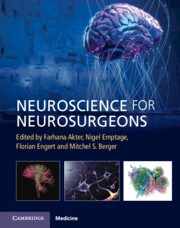Book contents
- Neuroscience for Neurosurgeons
- Neuroscience for Neurosurgeons
- Copyright page
- Contents
- Contributors
- Section 1 Basic and Computational Neuroscience
- Section 2 Clinical Neurosurgical Diseases
- Chapter 12 Glioma
- Chapter 13 Brain Metastases: Molecules to Medicine
- Chapter 14 Benign Adult Brain Tumors and Pediatric Brain Tumors
- Chapter 15 Biomechanics of the Spine
- Chapter 16 Degenerative Cervical Myelopathy
- Chapter 17 Spondylolisthesis
- Chapter 18 Radiculopathy
- Chapter 19 Spinal Tumors
- Chapter 20 Acute Spinal Cord Injury and Spinal Trauma
- Chapter 21 Traumatic Brain Injury
- Chapter 22 Vascular Neurosurgery
- Chapter 23 Pediatric Vascular Malformations
- Chapter 24 Craniofacial Neurosurgery
- Chapter 25 Hydrocephalus
- Chapter 26 Peripheral Nerve Injury Response Mechanisms
- Chapter 27 Clinical Peripheral Nerve Injury Models
- Chapter 28 The Neuroscience of Functional Neurosurgery
- Chapter 29 Neuroradiology: Focused Ultrasound in Neurosurgery
- Chapter 30 Magnetic Resonance Imaging in Neurosurgery
- Chapter 31 Brain Mapping
- Index
- References
Chapter 14 - Benign Adult Brain Tumors and Pediatric Brain Tumors
from Section 2 - Clinical Neurosurgical Diseases
Published online by Cambridge University Press: 04 January 2024
- Neuroscience for Neurosurgeons
- Neuroscience for Neurosurgeons
- Copyright page
- Contents
- Contributors
- Section 1 Basic and Computational Neuroscience
- Section 2 Clinical Neurosurgical Diseases
- Chapter 12 Glioma
- Chapter 13 Brain Metastases: Molecules to Medicine
- Chapter 14 Benign Adult Brain Tumors and Pediatric Brain Tumors
- Chapter 15 Biomechanics of the Spine
- Chapter 16 Degenerative Cervical Myelopathy
- Chapter 17 Spondylolisthesis
- Chapter 18 Radiculopathy
- Chapter 19 Spinal Tumors
- Chapter 20 Acute Spinal Cord Injury and Spinal Trauma
- Chapter 21 Traumatic Brain Injury
- Chapter 22 Vascular Neurosurgery
- Chapter 23 Pediatric Vascular Malformations
- Chapter 24 Craniofacial Neurosurgery
- Chapter 25 Hydrocephalus
- Chapter 26 Peripheral Nerve Injury Response Mechanisms
- Chapter 27 Clinical Peripheral Nerve Injury Models
- Chapter 28 The Neuroscience of Functional Neurosurgery
- Chapter 29 Neuroradiology: Focused Ultrasound in Neurosurgery
- Chapter 30 Magnetic Resonance Imaging in Neurosurgery
- Chapter 31 Brain Mapping
- Index
- References
Summary
Brain tumors in adults and children range from devastating malignant tumors with a dire prognosis to benign tumors that can be totally resected with a favorable outcome. The incidence rate for primary brain tumors in adults in the United States is approximately 23.8 per 100,000 persons. Of those, approximately two thirds are benign or borderline in nature. The most common benign tumor in adults is meningioma. The incidence in the pediatric population is approximately 6.1 per 100,000 children. However, the incidence of malignant brain tumors is higher in children than adults. We discuss the most common benign brain tumors in adults followed by a discussion on pediatric brain tumors.
- Type
- Chapter
- Information
- Neuroscience for Neurosurgeons , pp. 214 - 233Publisher: Cambridge University PressPrint publication year: 2024



